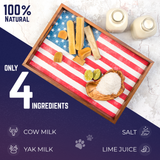Why Does My Dog Do That? How To Spot An Anxious Dog
As much as we love to joke about one day being able to translate dog thoughts into English or even what a dog would text to us if they had such an ability, the sad truth is our canine friends just don’t speak our language. Since they can’t speak, dogs communicate with us through their behavior and body language. If you really want to get to know your BFFF (best furry friend forever), you’ll have to learn what specific behaviors and postures mean. This is especially important when trying to spot an anxious doggo because a dog with anxiety can quickly turn from scared to aggressive if you ignore the warning signs.
It’s a good idea to take note of what your dog looks like when they are relaxed and happy. A comfortable dog will have soft round eyes that are full of color and shine. Their mouths are relaxed and some dogs even smile (a trait scientists believe dogs learned from watching their humans). Comfortable dogs will carry weight evenly on all paws. A playful pup will have goofy, bouncy, and over exaggerated movements. While playing happily a dog may engage in play-bows, paw slaps and quick turns in a circle. Once you are able to easily identify what your happy dog looks like, it will become easier to tell when they are distressed.

The dog life looks pretty appealing, you don’t have to work or do chores, you can sleep and play most of the time, and your family pets you and gives you treats. As enjoyable as it sounds, it does not mean that your pal won’t suffer from anxiety at times. Dogs can become anxious in crowds, during storms and fireworks, or when left alone. While some of these causes are short term and situation based, the separation anxiety can lead to long term issues.
Dogs experiencing acute anxiety can be dangerous, so you should be aware of general behaviors that tell you when to leave a strange dog you may encounter alone as well as what behaviors to look for in your own dog at home. If you have children, make sure they know how to recognize dog signals of distress so they know when it’s OK to pet and when it is not.
Here is a brief list of ten dog behaviors that signal acute (immediate) distress or anxiety.
#1. Hypervigilance:
This is when a dog who is afraid or confused can become hypervigilant which is a fancy way of saying he looks around a lot. A dog that is rapidly scanning their environment is displaying hypervigilance. This overstimulated pup will not be able to rest easy until they have calmed down.
#2. Intense Stare:
When a dog is afraid of something, it is not uncommon for it to lock its eyes onto the target of his fear. He can stare down a human being or a suspicious looking trash can with great intensity.

#3. Facial Expressions:
Remember when we said earlier that some dogs smile? Some dogs also “grimace,” which would be a tighter less relaxed version of a smile. It’s easy to get the two confused so be careful. If a dog appears to be smiling but at the same time displaying some other anxious behaviors it might actually be a sign of distress.
#4. Puppy Dog Eyes:
A dog’s eyes are very expressive. A sad dog will give you a longing stare that can break your heart in two million pieces. Frightened dogs have dull or cloudy eyes. They also blink excessively when under stress.
#5. Tails That Tell A Tale:
While happy dogs will wave their tails wildly in the air, dogs that are anxious will have lowered tails, sometimes tucked between their legs. A slow thumping tail might also be a signal of anxiety or sadness.

#6. Vocal Expression:
Barking, growling, whimpering and whining can all be symptoms of dog anxiety. If a dog is barking loudly or growling, do not reach towards it, even to calm it. This dog does not want to be touched.
#7. Dog Hair Problems:
Even short-haired dogs that are under stress will start to shed, a lot. A distressed dog’s hair might also stand up, especially along the back and tail. Dogs experiencing long term anxiety can also have dull or oily coats.
#8. Avoidance Behaviors:
If your dog keeps turning away from you, it might be stressed out. They might also try to leave the area or hide behind their owner. Have you ever seen a large dog hiding just his head to avoid a situation? While adorable, this dog is avoiding something he is afraid of and taking a “if I can’t see it, it can’t see me,” approach.
#9. Excessive Behaviours:
Dogs find repetition soothing so if you notice them doing something normal but in an exaggerated or excessive manor, they might be anxious. These behaviors can include things such as; drinking, licking, chewing, blinking, yawning and scratching. 
#10. Submissive Belly:
A dog that rolls over and shows its belly is letting you or whatever it is afraid of know that they are willing to give up their claim to dominance in that situation.
Most dog anxiety is situational and short lived and there are a number of things you can do to sooth and calm your anxious pet. Longer term anxieties such as general anxiety disorders and separation anxiety can be a little harder to spot and often take the disguise of naughty-dog behavior. Some pups get punished, or even abandoned, over behavior they could not control due to anxiety.
Here are a few examples of longer term anxiety in dogs: non-stop barking during the day, dribbling pee around the house, pacing, and chewing. The chewing and destruction of property is what gets a lot of dogs in trouble. Different than the actions of a teething puppy, anxiety chewing can be extreme, leading to significant household damage to walls, floors, doorways, windows and objects around the house. The good news is, obsessive chewing will stop when you are able to cure or control the separation anxiety. If you start to notice these behaviors your buddy is trying to tell you something, probably that he misses you or is afraid to be alone. Be a good owner and work with your dog and veterinarian to resolve anxiety issues.






